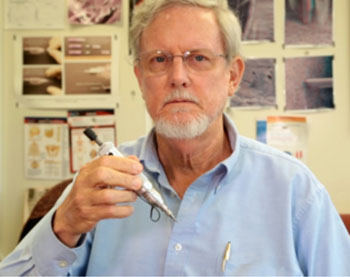Hand-Held Probe Measures Bone Strength
By HospiMedica International staff writers
Posted on 08 Apr 2015
A new device uses reference point indentation (RPI) to measure the mechanical properties of bone at the tissue level.Posted on 08 Apr 2015
The OsteoProbe device is a handheld device that uses RPI technology to inspect the bone material’s ability to resist indentation. The output is bone material strength index (BMSi), a figure that represents the ratio of the indentation distance in bone versus a polymathylmethacrylate (PMMA) reference material. The BMSi score represents resistance of the bone to separation of mineralized collagen fibrils. A BMSi of 90 or greater is considered excellent, 80–90 good, 70–80 fair, 60–70 poor, and below 60 is very poor.

Image: Professor Emeritus Paul Hansma and the OsteoProbe (Photo courtesy of UCSB).
A study conducted at the Mayo Clinic (Rochester, MN, USA) demonstrated the device's ability to successfully detect bone quality deterioration in diabetic patients, independent of bone mineral density (BMD). In another study conducted at Leiden University (The Netherlands), the OsteoProbe successfully distinguished between patients with and without fracture, not only in those with osteoporosis but also in those with osteopenia, the precursor to osteoporosis. The OsteoProbe was developed at UC Santa Barbara (UCSB; CA, USA), and is manufactured by ActiveLife Scientific (Santa Barbara, CA, USA).
“Bone fracture is becoming more and more of a serious problem as people live longer,” said Professor Emeritus Paul Hansma, PhD, of the UCSB department of physics. “It's exciting that it's now possible to measure BMSi in living patients and hopefully this can guide physicians in the future in choosing appropriate therapies to prevent bone fracture, especially in elderly people.”
RPI testing uses the location of measurement as the relative displacement reference position. The technique has its origins in the Mohs scale of mineral hardness, in which materials are ranked according to what they can scratch and are, in turn, scratched by. During the course of indentation, a record of the depth of penetration is made, and then the area of the indent is determined using the known geometry of the indentation tip. A record of these values can be plotted to create a load-displacement curve, which can be used to extract more sophisticated mechanical properties of the material.
Related Links:
Mayo Clinic
UC Santa Barbara
ActiveLife Scientific














